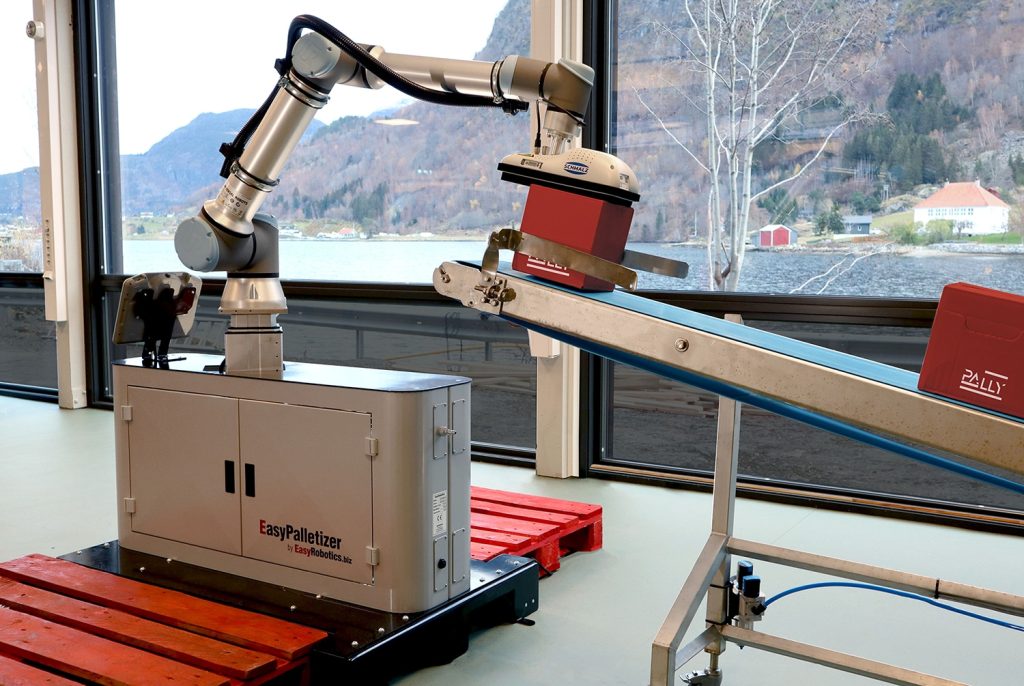Automation is an integrated part of the daily operations for many businesses. But still, there are a lot of manufacturers who are hesitant to adopt industrial robots, even though they are proven to make production incredibly effective.

The effectiveness of robots in production are no secret. In fact, automation is a great way for companies to stay competitive. In addition, there are also a lot of other great reasons for automating your production line.
Whatever the motivation for investing in automation; safety improvements, cost reduction, or labour shortages – there is a solution out there. It’s about doing research, forming a vision, defining your goals and make a plan for automation. Without this essential groundwork, you risk buying something you don’t really need.
In this article, we have found 5 challenges businesses can face when planning to automate palletizing – and how to overcome them. These challenges are in our experience, the most common “road to automation“ stoppers out there. Keep reading to learn how to improve your business by overcoming these initial challenges.

Automating Palletizing – 5 Possible Challenges
The following sections are split into individual technology adoption barriers. Stornelli et al. (2021) recognized most of these barriers in their literature review on advanced manufacturing technologies (AMT). The paper identifies technological, organizational, economic and personnel-related issues, keeping companies from adopting AMT.
In the context of cobot palletizing, we found it appropriate to add our acquisition barrier.
Let’s start off by learning how you can acquire a solution, as this process isn’t always too obvious.
1. Acquisition Barrier
If your production consists of boxes less than 20 kg and a production rate of less than 30 cases-per-minute, then you might be within range of utilizing palletizing cobots. To check if your products can be palletized by a cobot, you can simply visit the Fast Track to Cobot Palletizing.
Within a few minutes you can customize your own pallet online, fit for your production and palletizing need. By completing 3 easy steps you will receive a Digital Twin Simulation and a complete project analysis within 1 hour. This gives you both an upfront verification of its feasibility and the technical details about its performance, for free.
To proceed from here, the cobot palletizing search engine will further suggest possible solution providers based on your region. This will get you in contact with your local certified distributor/integrator about pricing and installation.
Once you find a solution that meets your requirements, you will have to onboard all the stakeholders. Not only do the decision-makers have a say in this, but the workforce should also be included. In this situation, you can easily share Digital Twin Simulations and the reports with stakeholders through a shareable link.
2. Technology barrier
It is common that people have the idea of robots being very complicated, and require expert knowledge to make them work. But this is not always the case with certain robot technologies. Cobots from Universal Robots are no exception.
More information about collaborative robots can be found here.
Especially with application-specific software, it makes cobots more accessible by simplifying the interface. These applications make it easier to configure advanced cobot tasks, like welding, material handling and palletizing. It also makes it easier to customize the solution to your specific needs.
Specifically for palletizing, the Pally software allows for easy operation where certified resellers can easily install, calibrate and train your staff. With 1 day for installation and 1 day for training, the cobot can be ready for your products coming down the conveyor.
The solution is also flexible. SMEs can benefit from this. The solution can adapt to more than just one specific project. Useful, as companies often offer more than just one product.
Pally, our palletizing software offers a no-code installation of the UR robot
Digital twin simulations will provide you with the reassurances you need. If you successfully run a digital twin simulation of a project, it means that you have tested that it will work. It’s not just a visualization. It’s a digital copy of a custom cobot palletizing solution, solving your palletizing need.
Alternatively to this simulation, you need a local integrator to physically construct and install your unique setup, to get the same information. This is an outdated alternative, and would be more costly and time-consuming compared to running a simulation online.
3. Organizational Constraints
In order to adopt an automated palletizing solution, you need to be able to communicate and execute the changes that comes with the investment. This is the part of the process where your groundwork of creating a vision, defining your company’s goals, doing your research, and planning for the future, come in handy! This will actually help organize the new production routines in a systematic manner.
In addition, it is valuable to be aware of the importance of management engagement in this process. By actively seeking relevant information, you will make a well-informed decision. By being open to new changes, executing and building new production lines, trust between the company and the supplier will grow.
As you slowly but surely get more knowledge about implementing and automating palletizing, we recommend reaching out to a supplier (integrator/distributor). Alternatively, you can always contact us at Rocketfarm if you want to talk about cobot palletizing.
Reach out if you would like to learn more about how Pally can help you achieve your goals in automated palletizing.
Brigt Grepstad Røysum
Channel Executive at Rocketfarm AS

4. Economic barriers
Depending on the solution you want to solve your requirements, the economic barriers can vary a lot. An industrial robot palletizing system for high-speed production lines, will be a lot more expensive than a smaller cobot palletizing solution, which is better suited for low volume/high mix production. But it’s still an investment that will meet internal economic barriers from decision-makers in your company.
The starting price of a Pally palletizing solution is 70k €, and this is the benefits of our solution:
- Return on investment within a year
- Easy to use
- Flexibility – can adjust to new products in a short time
To overcome the economic barriers, it’s important to do your groundwork. Do the ROI calculations and talk to similar businesses that have successfully implemented automation solutions. Listen and learn about their experiences. Gather the evidence that will convince the decision-makers in your company that a palletizing solution is a great solution to solve the challenges you are facing.
If you wish to learn more about what costs to think of when automating palletizing, this article can help you out.
Below is a statement from a manufacturing company in Norway. 3 Pally palletizing solutions have been running at their facility since 2015. In 2020 their Pally palletizing solution had a retrofit.
We are investigating how to create an increased production output, without making large investments. With this retrofit, we managed to increase the performance and give our collaborative palletizers, which have already many years ago returned their investment, a new and better life for many more years.
Inghild Lysne Sanden
Factory Manager Nortura Sogndal

5. Personnel-related barriers
The last challenge we are covering in this article, is the impact the switch may have on the employees. Some enterprises can have a dedicated workforce palletizing products manually, and these people could feel threatened by an automation solution.
In this situation, it is important to share the goal of the investment, and communicate these with the stakeholders. The best thing to do is to be open about your ambitions with automating palletizing. Listen to the employee’s concerns and don’t throw them under the bus. Let them know that you care for them, and discuss new opportunities that will arise as a consequence of the investment.
Even though cobots are meant to work beside people and need supervision, it can also create room to further grow and develop your team. These people are valuable to the company, and their skills can be used in other areas of the company, that require their knowledge. Maybe it can lead to a new position within the company, something more meaningful than just stacking cases.
f it wasn’t for our robot Stacky, I would have quit my job. I hate stacking cases of cases of cases on a f******g pallet.
Claus Bjerga
Packaging Manager, Ægir Brewery

Conclusion
As we mentioned early on in the article – creating a vision, defining the goal, doing research and making a plan for automating palletizing, are very important. However, a plan can only take you so far, as new barriers comes to mind.
The barriers presented here are influenced by research done by Stornelli et al. (2021), as well as our own experience within the industry. Now that you know about these barriers, we advice you to take action and continue your journey to automation with more research and planning.
If you think your company is ready to implement a cobot palletizing solution, you can visit the Fast Track to Cobot Palletizing. Then you can get a Digital Twin Simulation of your palletizing project, and verify if it is feasible. All you need is basic information about the product and how you would like to get them stacked!
If you want to learn more, subscribe to our monthly newsletter below to stay updated about robotic palletizing insights and case stories. Hopefully, this will help and inspire you to find and achieve your automation goals.
Sign up for our newsletter and get a FREE ebook
By signing up for our monthly newsletter, you’ll get case stories, product launches, and tips to automate your production line!
Additionally, you will instantly receive an ebook about implementing palletizing. For more information, please visit our newsletter subscription page.




